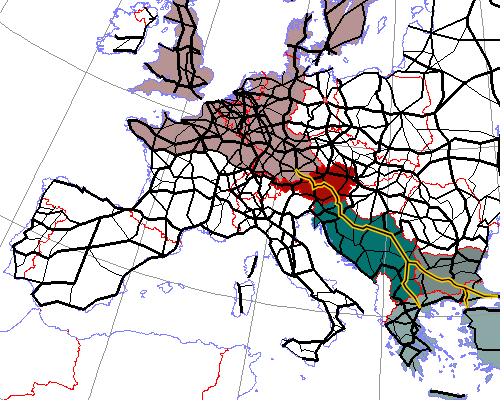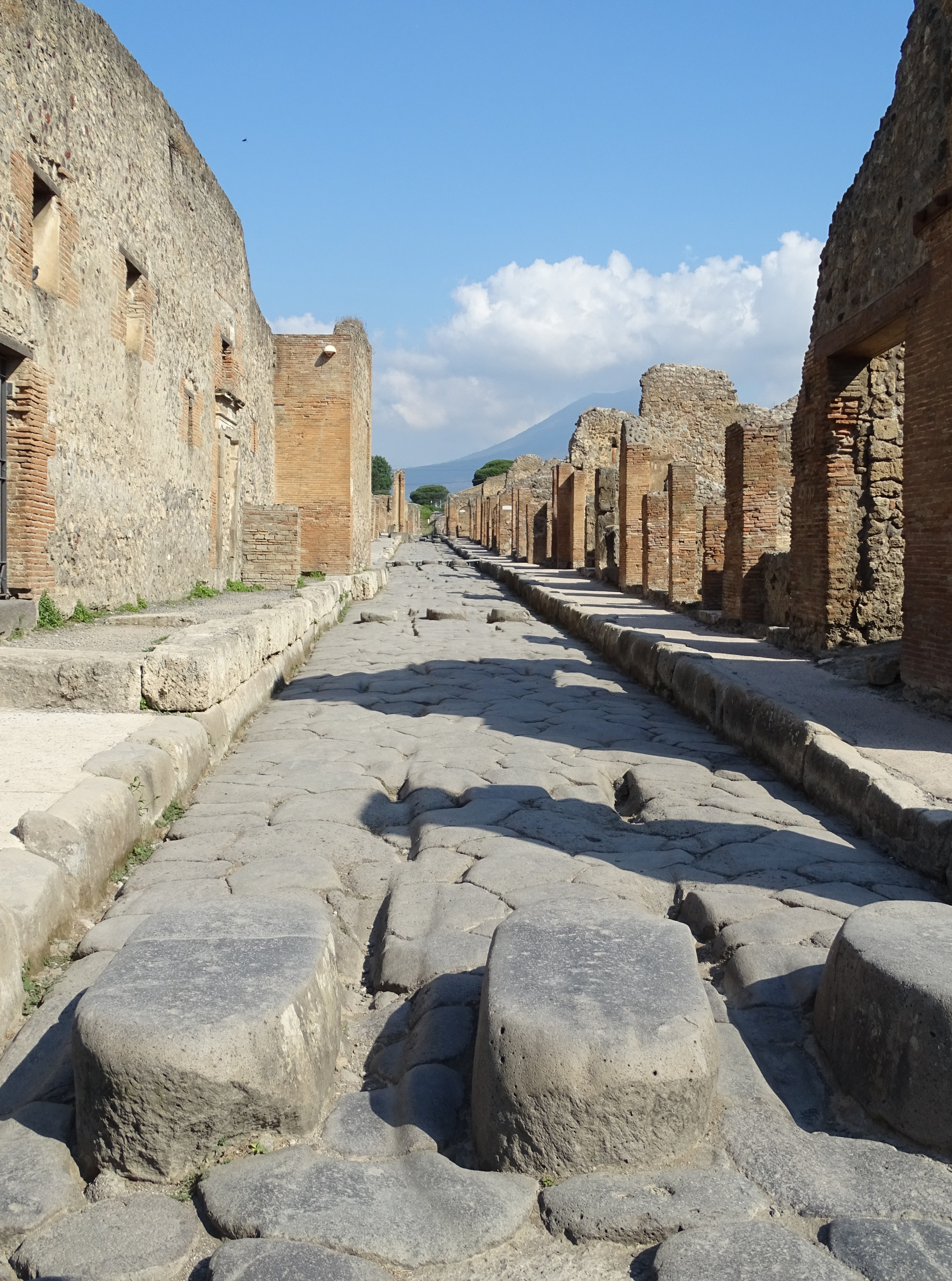|
Lueg Pass
Lueg Pass is a mountain pass or defile above the Salzachöfen Gorge in Salzburg State, Austria. The pass is at the western edge of the Tennen Mountains and is approximately above the Salzach river where Salzachöfen is at its narrowest. The terms Lueg Pass and Salzachöfen are sometimes used interchangeably to refer to the whole canyon. Lueg Pass, providing a natural access through the narrow gap, was historically one of the primary routes across the Northern Limestone Alps. Geography The Northern Limestone Alps are a northern parallel subrange of the Central Eastern Alps. The Berchtesgaden Alps, a constituent range of these mountains, form a barrier for north-south travel in the region. The Salzach river carves a deep valley through the mountains that culminates at Salzachöfen Gorge. Here, the banks of the Salzach become impassable and the route following the eastern edge of the river rises approximately above the river to avoid its most treacherous section before desce ... [...More Info...] [...Related Items...] OR: [Wikipedia] [Google] [Baidu] |
Salzburg (state)
Salzburg (, ; bar, Soizbuag, label= Austro-Bavarian) (also known as ''Salzburgerland'') is a state (''Land'') of the modern Republic of Austria. It is officially named ''Land Salzburg'' to distinguish it from its eponymous capital — the city of Salzburg. For centuries, it was an independent Prince-Bishopric of the Holy Roman Empire. Geography Location The state of Salzburg covers area of . It stretches along its main river — the Salzach – which rises in the Central Eastern Alps in the south to the Alpine foothills in the north. It is located in the north-west of Austria, close to the border with the German state of Bavaria; to the northeast lies the state of Upper Austria; to the east the state of Styria; to the south the states of Carinthia and Tyrol. With 529,085 inhabitants, it is one of the country's smaller states in terms of population. Running through the south are the main ranges of the Alpine divide (incl. the Hohe Tauern mountains) with numerous three-t ... [...More Info...] [...Related Items...] OR: [Wikipedia] [Google] [Baidu] |
Golling An Der Salzach
Golling an der Salzach is a market town in the Hallein district of Salzburg, Austria. Geography It is located on the southern rim of the ''Tennengau'' region south of the city of Salzburg. Here at the confluence of the Salzach and its Lammer tributary, the river leaves the Salzachöfen Gorge between the Berchtesgaden Alps and the Tennen Mountains ranges of the Northern Limestone Alps and flows northwards into the broad Salzburg basin. The Hoher Göll massif of the Berchtesgaden Alps in the west comprise the Schwarzbachfall Cave and the high Golling Waterfall, a natural monument. Parallel to the Salzach River, the historic Salzachtal Straße enters the narrow gorge at Lueg Pass. Golling station is a stop on the Salzburg-Tyrol Railway, served by ÖBB trains and the Salzburg suburban S-Bahn network. The market town also has access to the Tauern Autobahn (A10) from Salzburg to Villach. The municipal area comprises the cadastral communities of Golling, Torren, and Obergäu. Golling ... [...More Info...] [...Related Items...] OR: [Wikipedia] [Google] [Baidu] |
Gastarbeiter
(; both singular and plural; ) are foreign or migrant workers, particularly those who had moved to West Germany between 1955 and 1973, seeking work as part of a formal guest worker program (). As a result, guestworkers are generally considered temporary migrants because their residency in the country of immigration is not yet determined to be permanent. Other countries had similar programs: in the Netherlands and Belgium it was called the program; in Sweden, Denmark, Norway and Finland it was called (workforce-immigration); and in East Germany such workers were called . The term that was used during the Nazi era was (German for 'foreign worker'). However, the latter term had negative connotations, and was no longer used after World War II. The term is widely used in Russia (, ) to refer to foreign workers from post-USSR or third-world countries. Historical background Following World War II there were severe labour shortages in continental northern Europe, and high unempl ... [...More Info...] [...Related Items...] OR: [Wikipedia] [Google] [Baidu] |
Gastarbeiterroute
''Gastarbeiterroute'' is a German language slang term originating in the 1970s. It referred to the former European route 5, which started in Munich and terminated in either Istanbul or Thessaloniki. In summer, as well as for Christmas and Easter, so-called ''gastarbeiters'' working in West Germany, Austria and Western Europe would drive their automobiles south on the ''gastarbeiterroute'' through Austria and Yugoslavia to their countries of origin. It was notoriously dangerous for drivers and passengers who traveled on congested roads not suited to such heavy traffic. The route ran from Munich on the German Bundesautobahn 8 to Salzburg and further southwards on the Austrian Tauern Autobahn, which then ended at Golling at the northern rim of the Alps. Drivers had to take the highway (''Bundesstraße'') to Bischofshofen, Radstadt, and through the Enns valley to Liezen, Leoben, Bruck an der Mur, and Graz. The route passed the Austrian–Yugoslav border at Spielfeld and ran furthe ... [...More Info...] [...Related Items...] OR: [Wikipedia] [Google] [Baidu] |
Middle Ages
In the history of Europe, the Middle Ages or medieval period lasted approximately from the late 5th to the late 15th centuries, similar to the post-classical period of global history. It began with the fall of the Western Roman Empire and transitioned into the Renaissance and the Age of Discovery. The Middle Ages is the middle period of the three traditional divisions of Western history: classical antiquity, the medieval period, and the modern period. The medieval period is itself subdivided into the Early Early may refer to: History * The beginning or oldest part of a defined historical period, as opposed to middle or late periods, e.g.: ** Early Christianity ** Early modern Europe Places in the United States * Early, Iowa * Early, Texas * Early ..., High Middle Ages, High, and Late Middle Ages. Population decline, counterurbanisation, the collapse of centralized authority, invasions, and mass migrations of tribes, which had begun in late antiquity, continued i ... [...More Info...] [...Related Items...] OR: [Wikipedia] [Google] [Baidu] |
Roman Road
Roman roads ( la, viae Romanae ; singular: ; meaning "Roman way") were physical infrastructure vital to the maintenance and development of the Roman state, and were built from about 300 BC through the expansion and consolidation of the Roman Republic and the Roman Empire. They provided efficient means for the overland movement of armies, officials, civilians, inland carriage of official communications, and trade goods. Roman roads were of several kinds, ranging from small local roads to broad, long-distance highways built to connect cities, major towns and military bases. These major roads were often stone-paved and metaled, cambered for drainage, and were flanked by footpaths, bridleways and drainage ditches. They were laid along accurately surveyed courses, and some were cut through hills, or conducted over rivers and ravines on bridgework. Sections could be supported over marshy ground on rafted or piled foundations.Corbishley, Mike: "The Roman World", page 50. Warwick Pr ... [...More Info...] [...Related Items...] OR: [Wikipedia] [Google] [Baidu] |
Hagen Mountains
The Hagen Mountains (german: Hagengebirge) are a subrange of the Berchtesgaden Alps. They lie mainly in the Austrian state of Salzburg, the western quarter is in the Bavarian county of Berchtesgadener Land. The steep western flanks of the Hagen lie in Bavaria and drop in height to the basin of the Berchtesgadener Königssee. Geography The mountain range has an area of about 12 kilometres by 10 kilometres. Its highest peaks are located at its perimeter, its interior peaks being slightly lower. The two highest summits are the Großes Teufelshorn (2,363 m) south of the Röth and Kahlersberg (2,350 m). The Hagen mountains are linked Steinernes Meer by the ''Teufelshörner'' peaks, and to the Göll massif (Hoher Göll) via the col of Torrener Joch. In the north the Hagen is bordered by the Bluntau valley, in the east the Salzach valley forms a deeply incised boundary with the Tennen Mountains The Tennen Mountains (german: Tennengebirge) is a small, but rugged, mount ... [...More Info...] [...Related Items...] OR: [Wikipedia] [Google] [Baidu] |
Salzburg-Tyrol Railway
{{Infobox rail line , box_width = auto , name = Salzburg-Tyrol Railway , native_name = Salzburg-Tiroler-Bahn , native_name_lang = de , image = EC 163 bei Fieberbrunn, 08.12.2016.jpg , image_width = 300px , caption = EC 163 Transalpin passes the Kaiser Mountains. , type = Heavy rail, Passenger/Freight railIntercity rail, Regional rail, Commuter rail , status = Operational , locale = SalzburgTyrol , start = Salzburg Hauptbahnhof , end = Wörgl Hauptbahnhof , stations = 55 , open = Stages between 1873–1875 , close = , owner = Austrian Federal Railways , operator ... [...More Info...] [...Related Items...] OR: [Wikipedia] [Google] [Baidu] |
Tauern Autobahn
The Tauern Autobahn (A 10) is an autobahn (motorway) in Austria. It starts at the Salzburg junction with the West Autobahn (A1), runs southwards, crosses the Tauern mountain range on the main chain of the Alps and leads to the Süd Autobahn (A2) and Karawanken Autobahn (A11) at Villach in Carinthia. The Tauern Autobahn is part of the European route E55 from Sweden to Greece, its southern section also of the E66 from Italy (South Tyrol) to Hungary. Course It is long, of which are in 12 tunnels. The best known of these are the Tauern Tunnel and the Katschberg Tunnel that originally both had only a single bore, leading to chronic traffic congestions especially during summer holidays. The second bore of the Katschberg Tunnel opened in 2009, the second bore of the Tauern Tunnel in June 2011—after 35 years of traffic. From the West Autobahn junction at the Salzburg suburb of Wals-Siezenheim near the German border, the motorway runs southwards through the Salzach Valley bet ... [...More Info...] [...Related Items...] OR: [Wikipedia] [Google] [Baidu] |
Hallein District
The Bezirk Hallein is an administrative district ('' Bezirk'') in the federal state of Salzburg, Austria, and congruent with the Tennengau region. Area of the district is 668.31 km², with a population of 54,282 (May 15, 2001), and population density 81 persons per km². Administrative center of the district is Hallein. Administrative divisions The district is divided into 13 municipalities, one of them is a town, and four of them are market towns. Towns # Hallein (18,399) Market towns # Abtenau (3,324) # Golling an der Salzach (3,903) # Kuchl (6,431) # Oberalm (3,844) Municipalities # Adnet (3,324) # Annaberg-Lungötz (2,296) # Bad Vigaun (1,885) # Krispl (849) # Puch bei Hallein (4,088) # Rußbach am Paß Gschütt (803) # Sankt Koloman (1,497) # Scheffau am Tennengebirge Scheffau am Tennengebirge is a municipality in the Hallein district of Salzburg, Austria. Geography The municipality of Scheffau am Tennengebirge lies in the southern Tennengau of ... [...More Info...] [...Related Items...] OR: [Wikipedia] [Google] [Baidu] |
Berchtesgaden Alps
The Berchtesgaden Alps (german: Berchtesgadener Alpen) are a mountain range of the Northern Limestone Alps, named after the market town of Berchtesgaden located in the centre. The central part belongs to the Berchtesgadener Land district of southeastern Bavaria, Germany, while the adjacent area in the north, east and south is part of the Austrian state of Salzburg (''Salzburger Land''). Geography Mountains and lakes While the highest mountain of the Berchtesgaden Alps is the Hochkönig () located in the Austrian part, the best known peak is the Watzmann massif, the third-highest mountain of Germany at . The range also comprises the Obersalzberg slope east of Berchtesgaden, known for the former Berghof residence of Adolf Hitler. The picturesque heart is formed by the glacial Königssee lake with the famous St. Bartholomew's pilgrimage church and the smaller Obersee, both part of the Berchtesgaden National Park established in 1978. The range also comprises glaciers like ... [...More Info...] [...Related Items...] OR: [Wikipedia] [Google] [Baidu] |







